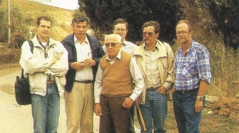

 Comptes Rendus Palevol
15 (7) - Pages 825-836
Comptes Rendus Palevol
15 (7) - Pages 825-836The Latest Miocene succession of the Baccinello-Cinigiano Basin in southern Tuscany (Italy) recorded a faunal turnover documenting the extinction of an older, insular, endemic faunal complex characterised by the extinct ape Oreopithecus bambolii and the setting of a new, continental, European faunal complex including the colobine monkey Mesopithecus. A similar turnover pattern (Late Miocene ape/Latest Miocene Cercopithecidae) is generally observed in Late Miocene continental successions of Eurasia, from Spain to central Europe, Southwest Europe, the near East, and Southwest Asia. Abundant literature reports that the Late Miocene Eurasian hominoid primate distribution closely tracks the climatic/environmental changes occurring during the 12–9 Ma interval, until their extinction in western Europe. In the primate record, the dispersion of Cercopithecidae and the contraction of hominids is interpreted as an event depicting a pattern of “continentalisation” in the Old World. The sedimentary succession of the Baccinello-Cinigiano basin, one of the longest continuous vertebrate-bearing continental successions in the Neogene Italian record, contributes to the debate on this hypothesis. This paper provides an overview of the main characteristics of the sedimentary succession, the chronological constraints (biochronology, radiometric datings, magnetostratigraphy), and the palaeoenvironmental evolution as derived from palaeobiological approaches and from the study of stable carbon and oxygen isotope contents along the entire sedimentary succession. The 2 myr geological history of the Baccinello Cinigiano Basin, which documents the evolutionary history of Oreopithecus and associated faunas, does not have a direct relation with the event of the Messinian Salinity Crisis. The evolutionary history of Baccinello-Cinigiano Basin and its palaeontological record have been mainly driven by the regional tectonism and palaeogeographic changes that affected the northern Tyrrhenian regions in Late Miocene (Latest Tortonian–Messinian) times.
Geological setting, Chronology, Palaeoenvironmental evolution, Oreopithecus faunas, Long continental succession, Late Miocene, Italy